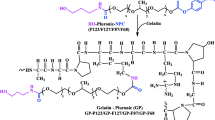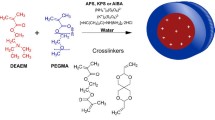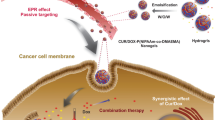Abstract
In order to improve the anticancer effect of drug, we designed and prepared biodegradable nanogel based on all-trans retinoic acid (ATRA)/pullulan conjugate (PURA). The nanogels have 47.19–38.24 % and 1.1–1.4 % of drug loading efficiency and drug contents, respectively. The controlled drug release and zero-order drug release behavior were shown for 10 days in the PURA nanogels. In the FACS data, the cellular uptake efficiency of doxorubicin (DOX) as an anti-cancer drug in PURA nanogel was similar with that of free DOX. DOX release from PURA nanogel was facilitated in cytosol due to and the polymer degradation. The cytotoxicity of PURA was restored by the polymer degradation up to that of free DOX as same concentration. Based on these, PURA nanogel has a possible potential for effective anticancer therapy.








Similar content being viewed by others
References
Allen TM, Mehra T, Hansen C, Chin YC (1992) Stealth liposomes: an improved sustained release system for 1-β-d-arabinofuranosylcytosine. Cancer Res 52(9):2431–2439
Bae B, Na K (2010) Self-quenching polysaccharide-based nanogels of pullulan/folate-photosensitizer conjugates for photodynamic therapy. Biomaterials 31(24):6325–6335
Bazile D, Prud’homme C, Bassoullet MT, Marlard M, Spenlehauer G, Veillard M (1995) Stealth Me. PEG–PLA nanoparticles avoid uptake by the mononuclear phagocytes system. J Pharm Sci 84(4):493–498
Dion LD, Gifford GE (1980) Retinoic acid induces a G1 cell cycle block in HeLa cells. Proc Soc Exp Biol Med 163(4):510–514
Duncan R (2003) The dawning era of polymer. Nat Rev Drug Discov 2:347
Fischer D, Bieber T, Li Y, Elsässer HP, Kissel T (1999) A novel non-viral vector for DNA delivery based on low molecular weight, branched polyethylenimine: effect of molecular weight on transfection efficiency and cytotoxicity. Pharm Res 16(8):1273–1279
Ganta S, Devalapally H, Shahiwala A, Amiji M (2008) A review of stimuli-responsive nanocarriers for drug and gene delivery. J Control Release 126(3):187–204
Gupta P, Vermani K, Garg S (2002) Hydrogels: from controlled release to pH-responsive drug delivery. Drug Discov Today 7(10):569–579
Iyer AK, Khaled G, Fang J, Maeda H (2006) Exploiting the enhanced permeability and retention effect for tumor targeting. Drug Discov Today 11(17):812–818
Jeong D, Na K (2012) Chondroitin sulfate based nanocomplex for enhancing the stability and activity of anthocyanin. Carbohydr Polym 90(1):507–515
Jeong B, Bae YH, Lee DS, Kim SW (1997) Biodegradable block copolymers as injectable drug-delivery systems. Nature 388(6645):860–862
Jeong D, Seo S, Na K (2012) Drug stabilization and controlled release from AB 3 type tetra block copolymer based polymersome. J Pharm Investig 42:1–8
Kazunori K, Glenn SK, Masayuki Y, Teruo O, Yasuhisa S (1993) Block copolymer micelles as vehicles for drug delivery. J Control Release 24(1):119–132
Langer R (1980) Invited review polymeric delivery systems for controlled drug release. Chem Eng Commun 6(1–3):1–48
Lee ES, Park KH, Kang D, Park IS, Min HY, Lee DH, Kim S, Kim JH, Na K (2007) Protein complexed with chondroitin sulfate in poly (lactide-co-glycolide) microspheres. Biomaterials 28(17):2754–2762
Leroueil PR, Berry SA, Duthie K, Han G, Rotello VM, McNerny DQ, Baker JR Jr, Orr BG, Holl MMB (2008) Wide varieties of cationic nanoparticles induce defects in supported lipid bilayers. Nano Lett 8(2):420–424
Li SD, Huang L (2009) Nanoparticles evading the reticuloendothelial system: role of the supported bilayer. Biochim Biophys Acta 1788(10):2259–2266
Liu M, Fréchet JMJ (1999) Designing dendrimers for drug delivery. Pharm Sci Technol Today 2(10):393–401
Lotan R (1995) Retinoids and apoptosis: implications for cancer chemoprevention and therapy. J Natl Cancer Inst 87(22):1655–1657
Lynch I, Dawson KA (2008) Protein–nanoparticle interactions. Nano Today 3(1):40–47
Moghimi S, Szebeni J (2003) Stealth liposomes and long circulating nanoparticles: critical issues in pharmacokinetics, opsonization and protein-binding properties. Prog Lipid Res 42(6):463–478
Müller R, Radtke M, Wissing S (2002) Nanostructured lipid matrices for improved microencapsulation of drugs. Int J Pharm 242(1):121–128
Na K, Park KH, Kim SW, Bae YH (2000) Self-assembled hydrogel nanoparticles from curdlan derivatives: characterization, anti-cancer drug release and interaction with a hepatoma cell line (HepG2). J Control Release 69(2):225–236
Ogris M, Kotha AK, Tietze N, Wagner E, Palumbo FS, Giammona G, Cavallaro G (2007) Novel biocompatible cationic copolymers based on polyaspartylhydrazide being potent as gene vector on tumor cells. Pharm Res 24(12):2213–2222
Petkovich M, Brand NJ, Krust A, Chambon P (1987) A human retinoic acid receptor which belongs to the family of nuclear receptors. Nature 330(6147):444–450
Seo SJ, Moon HS, Guo DD, Kim SH, Akaike T, Cho CS (2006) Receptor-mediated delivery of all-trans-retinoic acid (ATRA) to hepatocytes from ATRA-loaded poly N-p-vinylbenzyl-4-o-β-d-galactopyranosyl-d-gluconamide) nanoparticles. Mater Sci Eng C 26(1):136–141
Teramoto N, Shibata M (2006) Synthesis and properties of pullulan acetate. Thermal properties, biodegradability, and a semi-clear gel formation in organic solvents. Carbohydr Polym 63(4):476–481
Torchilin VP (2001) Structure and design of polymeric surfactant-based drug delivery systems. J Control Release 73(2–3):137
Wong HL, Bendayan R, Rauth AM, Xue HY, Babakhanian K, Wu XY (2006) A mechanistic study of enhanced doxorubicin uptake and retention in multidrug resistant breast cancer cells using a polymer–lipid hybrid nanoparticle system. J Pharmacol Exp Ther 317(3):1372–1381
Author information
Authors and Affiliations
Corresponding author
Additional information
Jieun Lee and Dooyong Jeong contributed equally to this work.
Rights and permissions
About this article
Cite this article
Lee, J., Jeong, D., Seo, S. et al. Biodegradable nanogel based on all-trans retinoic acid/pullulan conjugate for anti-cancer drug delivery. Journal of Pharmaceutical Investigation 43, 63–69 (2013). https://doi.org/10.1007/s40005-013-0055-6
Received:
Accepted:
Published:
Issue Date:
DOI: https://doi.org/10.1007/s40005-013-0055-6




